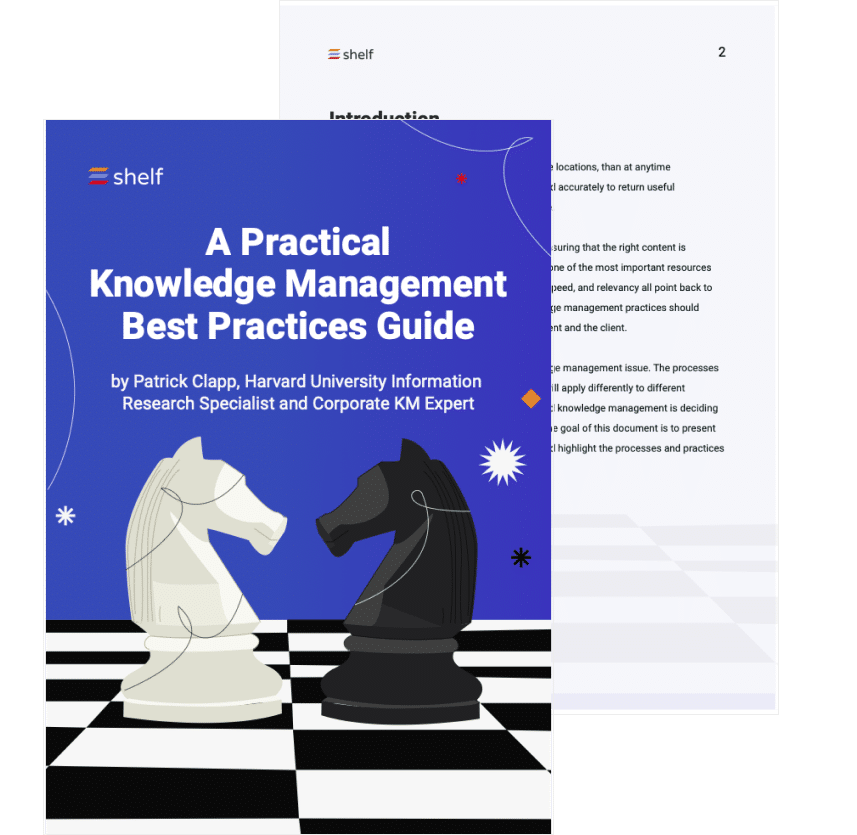The idea is to create a central repository for all your company’s information, to make information easy to organize, easy for employees to find. But how will you create this repository without bogging down your team with yet another task? And how can you be sure that employees will use it?
This guide will walk you through creating an internal knowledge base, from planning and design to implementation and maintenance.
Step 1
Assess your organization’s knowledge needs
Before you decide that an internal knowledge base is the best choice, first take a step back and assess your organization’s needs. Ask yourself the following questions:
- What kind of content types does the company need to store or create?
- Do we need an internal knowledge base for employees only—or a KM platform that can push knowledge to customer-facing channels?
- Is organizing internal knowledge for internal use more important than delivering knowledge?
Select the best knowledge solution for your current business needs
Knowledge bases are suitable for small, growing companies that need an organized way to author and categorize information. If you are a B2C company, it’s important to note that many companies graduate from internal knowledge bases or solutions like SharePoint to an enterprise KM platform.
Here’s why: A KM platform can automate a lot of manual work—like using AI to identify knowledge gaps and offer insight. Whenever you must deliver answers externally—like to agents within a contact center—you need something more than a knowledge base.
Step 2
Ensure your knowledge base ranks high for usability
Before you migrate content or create an internal knowledge base, you need to select a solution people will actually love to use. After all, what’s the point of putting all this effort into creating a repository of knowledge if no one ever refers to it?
Here’s what to look for in your existing knowledge base or if you are reading reviews, exploring vendors, and narrowing down your options.
Prioritize search
The search function is an essential feature of a knowledge base, especially if any customer support agent will depend on it. While search functions on knowledge base products aren’t great, no one should have to perform Ctrl+f searches to find things.
Optimize the UX
Many internal knowledge base solutions look great, but can be really clunky for admins, creators, and users in general. Ensure the tool you use makes it intuitive for both creators to add articles, wikis, and other content types.
The best knowledge bases are those easy to use; if the experience is clunky, expect low adoption.
Make content easy to consume
Make sure content is well written and easily consumable, especially if you’re bringing over poorly formatted content. Sometimes it’s best to skip the import entirely.
It helps to establish some style guidelines for all creators, so the knowledge created remains consistent. Your knowledge team should train all creators to use headings and subheadings properly, to present information to an audience in a helpful way.
Prioritize analytics and feedback
If you want to ensure knowledge can be useful, your knowledge base should (at the very least) have some built-in analytics on content views or general engagement.
Although usually a feature of KM platforms, content health and analytics will make content maintenance a lot easier. As your organization and customer base grows, features like automated content maintenance found in a more sophisticated knowledge tool is critically important.
Many internal knowledge bases encourage populating the knowledge base (sharing knowledge), but try to focus on content quality and accuracy. If you decide to make this content available to customers, you don’t want a bunch of poor quality articles.
Step 3
Decide on a single source of truth for knowledge
It’s tough to keep track of changes and versions if you have multiple people working on the same thing in different places. It also causes confusion. Imagine trying to find the most recent version of a document saved in three different places. What a nightmare!
Even though knowledge bases aren’t designed to publish or surface knowledge everywhere, you still shouldn’t try to manage multiple internal repositories like Google Drive or SharePoint.
Choose one central location to store all your company’s knowledge, and make sure employees recognize this source of truth.
Step 4
Organize your knowledge management team
After you decide on a source of truth, it’s time to start organizing your knowledge management team.
Remember, the goal of a knowledge management team is to ensure that the information in your knowledge base is accurate, up-to-date, and easy to find. Be sure to assign specific roles and responsibilities to different team members to do this effectively.
At minimum, you will likely need a technical administrator and knowledge manager to manage the instance. You also will want a group of knowledge contributors— like subject matter experts and people who only leave feedback.
Your internal KB should include features you need to involve other people, to create a feedback loop—an essential component to accurate, up to date knowledge.
Check out this post on KM roles and responsibilities for a quick overview on a typical knowledge management team setup.
Step 5
Use an intuitive taxonomy
Once you have a knowledge team assembled, make sure you use a taxonomy that makes sense to employees. This is a knowledge management best practice that can absolutely save employees time.
In this stage, you should:
- Implement your folder structure
- Apply category names
- Define how to use tags
- Create connections to related content (if this feature exists)
Any good KB will include these basic features by default. Once implemented, you can easily expand and alter your taxonomy structure as the company grows and adds new departments.
Step 6
Use integrations to your advantage
There are a variety of knowledge bases on the market, each with its own set of features and integrations. When you’re choosing a platform for your internal knowledge base, take some time to consider which integrations would be most beneficial for your team.
If you use Google Drive or Microsoft 365 for storing documents, look for a KB that offers integration with one of these services. Communication apps like Slack are also common in the internal KB category because they can save time. With this integration, you can effortlessly search for knowledge-base articles from within Slack without ever having to leave the app.
Your knowledge base should integrate into the basic internal environment you rely on. If users must open a new tab to search through an internal knowledge base…chances are it won’t get used quite as often.
Constantly assess your knowledge management needs
Any knowledge solution should deliver the right answer, in the right place at the right time—it’s up to you what environments you need to support, whether that be internally or externally. As your organization grows, you may find you need more than an internal knowledge base to support new CX software, phone systems, and live chat tools.
Make it a habit to audit your tech stack from time to time so you can be confident you have the best knowledge management software for the job.





